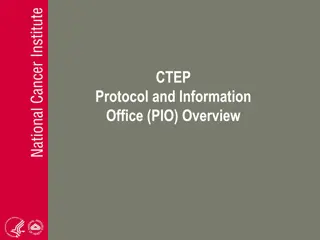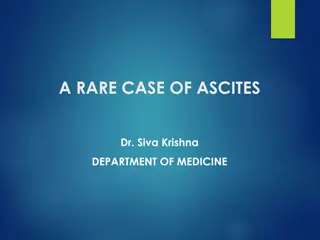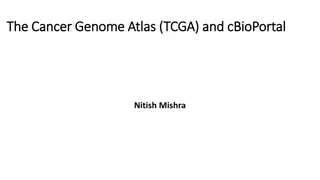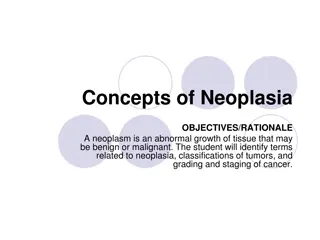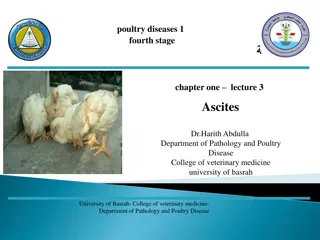Management of Malignant Ascites in Advanced Cancer: ESDO Learning
Malignant ascites is a challenging complication of advanced cancer, impacting patient quality of life and survival. Diagnosis involves imaging and cytology, with poor prognostic indicators. Management includes symptom relief with diuretics, paracentesis, and catheter options. Refractory cases present a therapeutic challenge, with limited options to extend life expectancy.
Download Presentation

Please find below an Image/Link to download the presentation.
The content on the website is provided AS IS for your information and personal use only. It may not be sold, licensed, or shared on other websites without obtaining consent from the author.If you encounter any issues during the download, it is possible that the publisher has removed the file from their server.
You are allowed to download the files provided on this website for personal or commercial use, subject to the condition that they are used lawfully. All files are the property of their respective owners.
The content on the website is provided AS IS for your information and personal use only. It may not be sold, licensed, or shared on other websites without obtaining consent from the author.
E N D
Presentation Transcript
Management of Malignant Ascites in advanced stage cancer ESDO Learning Bytes 2021 Elisabeth Stragier Gastroenterology Dep., Jessa Hospital, Hasselt, Belgium Digestive Oncology Dep., University Hospitals Leuven, Belgium
CONTENT Scope of the problem: Definition/etiology, signs and symptoms Diagnostic steps (and differential diagnosis with ascites due to cirrhosis) Outcomes Management Practical tips en tricks: take home messages
Malignant ascites: scope of the problem MA = ascites in patients with cancer due to a multifactorial process involving peritoneal metastasis, hepatic metastasis, increased vascular permeability and/or lymfatic obstruction. +/- 10% of cases Most commonly in ovarian cancer (25-28%), also associated with colorectal, pancreatic, uterine, gastric and primary peritoneal cancers. Abdominal pain Dyspnea Vomiting Anorexia Impaired movement Fatigue Abdominal distention Visceral compression Loss of proteins/elektrolytes MA = Poor prognostic factor with detrimental effect on quality of life Reported prognosis for survival at time of diagnosis from 1to 6 months Hodge et al., 2019 Hicks et al., 2016 Sangisetty et al., 2012
Malignant ascites: Diagnostic steps (and differential diagnosis with ascites due to cirrhosis) MA : diagnosed with US or CT-scan 75-80% of all cases due to cirrhosis 10% of all cases of ascites = MA Positieve cytology for malignant cells High ascitic fluid protein Low SAAG High SAAG Hodge et al., 2019 Chung M et al., 2008 Rosenberg et al., 2006
Malignant ascites: Outcomes Poor prognostic indicators = Concomitant with decreased nutrition with impaired immune respons oedema low serum albumin liver metastasis Poor overall prognosis treatment options must be carefully evaluated preference for treatments less invasive preference for treatments with better control of ascites-related symptoms
Malignant ascites: Management REFRACTORY ASCITES = is refractory to systemic therapy, including diuresis. Several options BUT non of them show to extend life expectancy Diuretics and sodium restriction less efficacy in MA Symptom relief Spironolactone Diuretics Most common treatment modality Effective in relieving symptoms Requires frequently repeated treatments Paracentesis Variety of different indwelling catheters (ex Tenckhoff) Cave infections, peritonitis for non-tunneled catheters Not in loculated ascites, coagulopathy, infected peritoneal cavity Complications: infections, leakage, cath dislodgement, cellulitis, abd pain, peritonitis Tunneled catheters Theoretical benefit of returning ascites fluid to circulation LeVeen shunt (fluid into SVC via one-way valve) Not in hemorrhagic ascites. Highest rate of complications: oedema, fever, tachycardia, leakage, PVS dysfunction, DIC, GI bleeding, sepsis, heart failure Peritoneovenous shunts Intraperitoneal catumaxomab = non-humanized monoclonal antibody.Target = EpCAM on Tcells Tumor cells in malignant effusions express EpCAM in 70-100% the amount of circulating tumor cells in peritoneal cavity and thus the production of MA Hyperthermic intraperitoneal chemotherapy HIPEC without CR surgery Treat microscopic disease and avoid sytemic toxicity
Malignant ascites: Practical tips and tricks: take home messages MA carries poor prognosis Diuretics and sodium restriction = traditional first line treatment DO NOT work well for MA unless it occurs due to liver metastasis Paracentesis = effective temporary but not durable solution More durable : Tenckhoff catheter , PVS and IP chemotherapy (Catumaxomab and HIPEC) . QOL but no improvement in overall survival Risks versus benefits of different managment options







